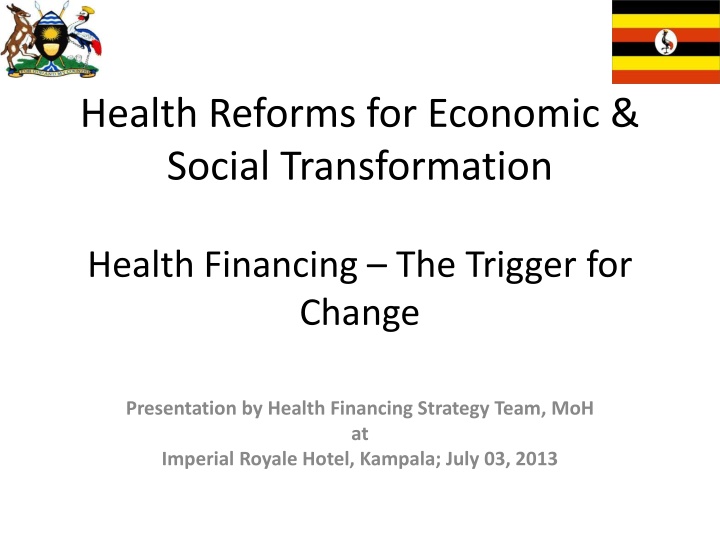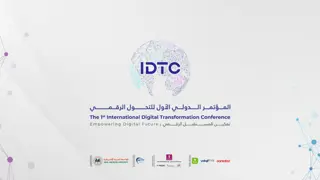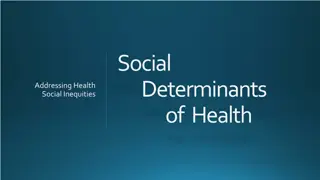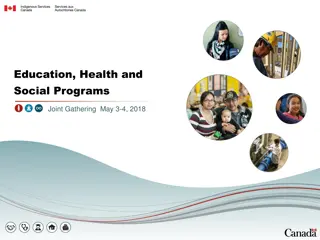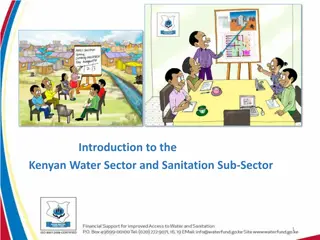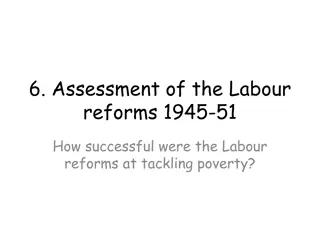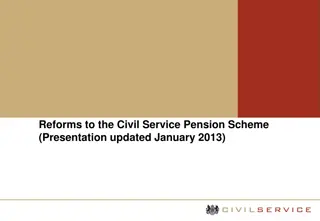Health Reforms for Economic & Social Transformation
"This presentation by the Health Financing Strategy Team at Imperial Royale Hotel in Kampala discusses health financing as a key driver for economic and social change. The team highlights the importance of health reforms in driving transformative impacts on society, offering valuable insights and strategies for stakeholders involved in healthcare policy and decision-making."
Download Presentation

Please find below an Image/Link to download the presentation.
The content on the website is provided AS IS for your information and personal use only. It may not be sold, licensed, or shared on other websites without obtaining consent from the author.If you encounter any issues during the download, it is possible that the publisher has removed the file from their server.
You are allowed to download the files provided on this website for personal or commercial use, subject to the condition that they are used lawfully. All files are the property of their respective owners.
The content on the website is provided AS IS for your information and personal use only. It may not be sold, licensed, or shared on other websites without obtaining consent from the author.
E N D
Presentation Transcript
Health Reforms for Economic & Social Transformation Health Financing The Trigger for Change Presentation by Health Financing Strategy Team, MoH at Imperial Royale Hotel, Kampala; July 03, 2013
WHO MOVED MY CHEESE? By Spencer Johnson Dealing with change in Your Work and Life
The Presentation Reminder on Key Definitions Health System Levers Organization /Governance Financing Providers Regulation Behavior Way Forward Reform Secretariat
Reminders Health: Health is a state of complete physical, mental and social well-being and not merely the absence of disease or infirmity Health System: All the organizations, institutions, and resources that produce health actions / activities that promote, restore, and maintain health
Health System Levers 1 Organization HS structure, Governance & individual institutions Financing how money for the HS is raised & allocated Payment how the funds are distributed Regulation how influence behavior of providers, insurance
Health System Levers 2 Behavior how improve health system performance through individual change programs Multi-sectoral action - collaboration & synergies within & across sectors to deliver a healthy population Community engagement
The Health System: Measurement Intermediate Performance Measures Performance Goals Efficiency: Technical & Allocative Health status Degree of satisfaction Quality Financial risk protection Access
CHECK LIST: ORGANIZATION Is the overall structure and mix of organizations conducive to Health Sector performance? Do the different elements focus on their mandates? Do synergies exist between the different elements of the Health System structures? Are there adequate internal institutional incentives to enhance performance of the Health system?
Internal Administration- Regional Health Workforce Characteristics Medical Management 90% 83% 78% 80% 69% 70% 57% 60% 50% 43% 40% 31% 25% 30% 17% 20% 10% 0% Africa West Pacific Europe America 9 Source: WHO, 2007
CHECK LIST: ORGANIZATION How are resources mobilized Who bears the financial burden Who controls the expenditure Who gets paid and how Risk protection Nature of Benefits Package Equity Governance of revenues Community engagement RESOURCESSHOULDBEINONEBASKET, ATDISTRICTLEVEL, TOENABLECONTEXTSPECIFICRESOURCE WEIGHTING . CAOs & Town Clerks Health Sector Consultations Kampala 2012 10
Financing: Policy Questions Who bears the financial burden Control Who gets paid and how Equity Governance of revenues Community engagement
Purchasing Modalities Line item budget: Case load, staff , past budget - funds not fungible across budget lines Capitation: Fee for each registered population irrespective of services requirement Salary: based on time period at work Payment ceiling
Regulation Use of coercive power-through legal instruments - to impose constraints on organizations and individuals to: Establish basic conditions for honest market exchange Perfect what markets cannot do to ensure equitable access to basic health services Correct market failures and provide public and merit goods Correct unacceptable market results 13
Behaviour 4 categories of individual decisions that affect HS performance: Treatment seeking Health Professionals Patient compliance Lifestyle & prevention 14
Behavior Change Strategy: Social Marketing Product Definition demographics, population psychosocial profiling, functionality Place: where & how to communicate Price: Maximize adopters; Social equity; Cost recovery; De-marketing; Profit maximization Promotion: Product aspects; Presentation; Channel; Trigger 15
Governance & Stewardship Generation of evidence for policy Forums to inform policy at all levels Mechanisms to resolve conflict Capacitate governance structures 16
Health Sector Plan (NHPII)reminder Vision Mission To provide the highest possible level of health to all people in Uganda through promotion, prevention, curative and rehabilitative/palliative health services at all levels To have a healthy and productive population that contributes to economic growth and national development. 17
The National Health Policy (NHPII) reminder Focus: Health promotion, Disease prevention, Early diagnosis and treatment of diseases Priority Areas: Efficiency in use of available health resources Strong public - private partnerships for health Strong Health system Universal access to a minimum health care package Equitable and sustainable financing mechanisms
Health Sector Prioritiesreminder Resource mobilization & transforming the healthcare financing system Promoting community participation and ownership A comprehensive knowledge management approach Transforming leadership and management practices Strategic human resource management Improving the Quality, Safety, Cost and Value of Health Care Strengthening public private partnerships Upgrading and modernizing health infrastructure
HSSP Priority Interventions.reminder 1 Contextualize strategic interventions Comprehensive approach to health services delivery A comprehensive knowledge management approach Equity in health as a priority Understand needed investments Innovate to guide organization and management Comprehensive Health Financing Strategy Sector Governance (coordination and partnership)
HSSP Priority Interventions.reminder 2 Transformation of leadership and management practices Promotion of community participation and ownership Strategic human resource management Modernizing health infrastructure Improvement of the Quality, Safety, Cost and Value of Health Care Establishment of a comprehensive knowledge management system Strengthening public private partnerships Transformation of the health financing system
Health Sector Strategic Plan Focus (HSSP) Sexual and Reproductive Health Child Health Control and Prevent Communicable Diseases Health Education and Promotion
Trigger for Change The Health Financing Strategy Whoever Pays the Piper Calls the Tune 23
Health Financing Vision, Mission, Values Pillars / Principles Reforms Goals Objectives Strategies Way forward 24
Challenges for Health Financing 1 Inadequate financial resources Reliance on OOP spending Misappropriations & wastage Not equitable 25
Challenges for Health Financing 2 Ever evolving service standards, norms & technologies Fragmented no cross-subsidization No pooling of contributions Significant source through development partners & global initiatives
Challenges for Health Financing 3 High population growth rate New disease patterns Political pressure fees, new units, infrastructure intensive health plans
Health Financing Definition / Functions Collection: How the health system raises money from households, businesses & and external sources Pooling: The accumulation and management of collected revenues to enable members of the pool share collective health risks Purchasing: The mechanisms used to secure services from public and private providers. 28
Key Challenges for HF in Uganda Inappropriate sector organization and management Absence of an integrated management and a holistic community information system Inadequate involvement of health sector stakeholders Resource availability, misapplication, wastage Financial hardship / impoverishment from direct under /over the counter payments for health 29
Determinants of HF for Universal Coverage Income {GDP=F(health expenditure)}; LIC/HIC Population age structure & epidemiological requirements (HIV/MMR) Technological progress & variation in medical practice Health system characteristics (type of service - PHC, insurance, external funds, doctor supply) 30
Vision, Mission Vision: a Health Financing Model that best fits Uganda s Health Sector Aspirations Mission: to facilitate universal access to affordable quality health services by all Ugandans 31
Values 1 Equity: access health services in accordance with health needs and not ability to pay. Solidarity: the better-off should support the cost of healthcare for the poor; young , ageing and old; the healthy to contribute towards the cost of care for those who are sick. Responsibility: Ugandans should own their health and address their own health seeking behavior; stakeholders should accept their duties and obligations 32
Values2 Transparency: access to information regarding the operation of the system and /or as required by any law or professional etiquette/practice; patients should receive sufficient information about their treatment, health and well-being. Accountability: the HFS will strive for the highest standard of technical, financial and political accountability value for money. 33
Long Run Goals..1 Promoted the effective use of the health system, including participating in promotive activities & utilizing preventive services Protected Ugandans from health related financial shock Promoted efficiency in the provision of health services 34
Long Run Goals 2 Improved the effectiveness and efficiency of revenue collection and risk-pooling Increased the quality of healthcare to all Ugandans Improved governance and transparency in order to optimize the use of resources 35
Long Run Goals 3 Improved aid effectiveness in the health sector Ensured sustainability of the healthcare financing system in the country Promoted multi-sector and public private partnerships approach to health service delivery 36
Financing Goals for HS Reform Goal 1: Effective organization & Governance Ensure purchase of health services in ways that are allocatively & technically efficient Goal 2: Resource Mobilization Mobilize enough revenue for a basic package of essential services & to ensure financial protection against catastrophic medical illness Goal 3: Social Health Protection & Effective Risk Pooling Manage health revenues to pool health risks equitably and efficiently 37
Goal 1: Effective organization & Governance Objective: Strengthen institutional arrangements for improved efficiency, accountability, transparency 38
Goal 1: Strategic Interventions1 Focus on Mandates at all levels Separate medical care from public/population health activities Ensure services are of adequate quality Strengthen the Referral System 39
Goal 1: Strategic Interventions2 Split the Purchaser and Provider Roles; Buying Outputs not Supplying Inputs Strengthen planning & management capacity alongside greater autonomy set standards Make more effective use of the Private Sector
Goal 1: Strategic Interventions Transparency in determining the benefit package and levels of provider reimbursement Ensure development partners make more use of country mechanisms Effective, coordinated & integrated health management information system to embrace all sector stakeholders at each level, including the community
Goal 2: Resource Mobilization1 Objective: Raise adequate funds to finance a minimum package of services 42
Goal 2: Resource Mobilization2 Establish/ Designate a Health Revenue Collection Mechanism Community Health Savings Continuous Review of the Case for Earmarked Taxes Especially where there are Potential Public Health Gains Health Bond and other Financing Instruments 43
Goal 3: Social Health Protection & Effective Risk Pooling 1 Objective Develop a financing system which guarantees access to quality healthcare for all Ugandans, especially the poor and vulnerable groups 44
Goal 3: Strategic Interventions Community engagement and other stakeholder coordination /collaboration mechanisms Set up mechanisms to manage the National Health Services using pooled funds Harness Informal / Private Sector & Philanthropy financing potential 45
Goal 3: Strategic Interventions Put in place strong provider incentives Protect the poor and vulnerable groups Ensure a Broad Benefits Package
Reality Check: Top 5 Causes of Morbidity Out Patients Malaria In Patients Malaria (31%) Non-pneumonia cough/cold Anemia (7%) Intestinal worms Pneumonia (6%) Skin disease Respiratory Infections (4%) Diarrhea Injuries (4) Source: Health Accounts Study, 2008-10, MoH 47
Reality Check: Top 5 Causes of Mortality Malaria (14%) HIV/AIDS (10%) Pneumonia (8%) Aneamia (8%) Tuberculosis (6%) Source: Health Accounts Study, 2008-10, MoH 48
Reality Check: Leading Causes of Maternal Mortality (Regional Estimates SSA, 1997-2007) 20% 19% 18% 17% 17% 16% 14% 12% 11% 10% 9% 9% 8% 6% 4% 2% 1% 0% Bleeding High Blood Pressure Indirect Direct-other Abortion Sepsis Embolism Source: Countdown 2015 Uganda 49
Reality Check: Determinants of Maternal Mortality: the Three Delays Personal & Home Environment Gender, education, culture, income Infrastructure Roads, Transport Health Facility Health worker, technology SWK - SPA/PH, MoH 50
